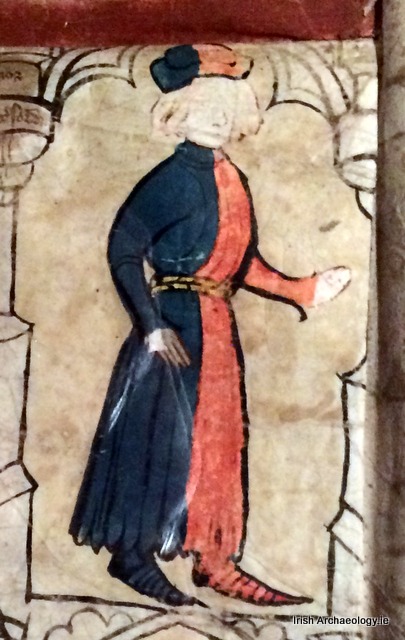
In the imaginative and engaging Charter Roll room of the Medieval Waterford Museum, I discovered something that I’d never seen before: a fourteenth century illustration of a man dressed from head to toe in two vertically contrasting colours.
He is dressed in an outfit that vertically drapes the entire left half of his body in fawn, and the entire right half of his body in red.
This means that each and every item of his attire is divided down the centre of his body into two colours: his tunic (or gipon), his shoulder cape; his hat, his hose; he even wears two different colour shoes and two different-colour feathers in his hat to co-ordinate exactly with the rest of his ensemble. The stylist has stuck almost ruthlessly to the two chosen colours: the only items on his person that are not in these colours are his jewellery: the gold brooch that attaches alternate feathers to his hat, and his gold belt (in the illustration, the gold colour has since faded to grey).
The person represented is Geoffrey De Geneville, Justiciar for Ireland in the years 1273-1276. This portrayal of him was created about 100 years after he had held the position of Justiciar, which is roughly equivalent to the role of a present-day Taoiseach (Prime Minster). This trend of splitting a costume’s colour scheme in two even halves down the centre of the body is known as parti-coloured, or sometimes as mi-parti fashion, and was in vogue during the fourteenth century for both men’s and women’s fashion.

The illustration is part of an extraordinary 1372 document known as The Great Charter Roll. It was created on vellum and rolls out to an impressive length of almost 4 metres. Curiously, it is extremely richly illustrated; its makers used individual historic documents and sewed them together with newly created visuals of official and royal personages associated with Waterford. Illustrating an official document in this way was unheard of; its intent was to impress and even intimidate its viewers in a legal dispute over shipping laws in Waterford Harbour, and part of its legacy is a vibrant and detailed insight into costume fashion in the fourteenth century.
There are also two other characters on the Great Roll depicted in split-coloured costume: the mayor of Waterford himself, along with another Justiciar, John Darcy, in office from 1322-1333.
Justiciar John Darcy wears ceremonial robes parti-coloured in blue and yellow. His houpellander reaches to his ankles, and matching embroidered shoes and shoulder cape fastened with a large round brooch, and matching ornate hat. He wears his knightly belt fashionably low on the hips.

The Waterford mayor is shown in contrasting vertical red and blue throughout his houpellande (a long, loose garment worn to the ankles by women and men and which could also be worn just to the buttocks by men), hat and shoes.
Red and blue were a popular colour combination in fourteenth century clothing and interior decor; and red and blue feature heavily in the strong, bright colours used throughout the entire Waterford Charter Roll, and have been used throughout the decor of the exhibition room that it now inhabits.
The effect of dress like this is – to my eyes – both bizarre and striking. The attention to detail is remarkable: the kind of forward planning an outfit that requires two differently-coloured poulaine shoes (those distinctive fourteenth century shoes with the long, narrow pointed toes) is worthy of comment. How many other similar outfits did someone like Justiciar Geoffrey De Geneville possess in his wardrobe? How many varying brightly coloured single shoes? Would our current Taoiseach consider wearing two different shoes in the name of fashion?
If you can’t get to Waterford museum in the near future, their website has an extremely useful virtual tour facility, which you can access here.
By Adrienne Corless
Further Reading
McEneaney, E. & Ryan R. (eds) 2004 Waterford Treasures, M.Y. Gallaghers, Waterford.



That is pretty cool,I for one like the two colour split design.A few years ago I had a nice sweater that was split from left shoulder to right hip with a black line about 1 cm wide.The shoulder area was a cream colour while the other was a nice burgundy colour.I received a lot of questions about it whenever I wore it,and the majority were where I got it ,and if there were other colours available.It just seemed like an unusual colour pattern,but it was very noticeable in a crowd.Maybe that is one of the reasons these gents wore these outfits.So they could be easily recodnized in their official capacity.